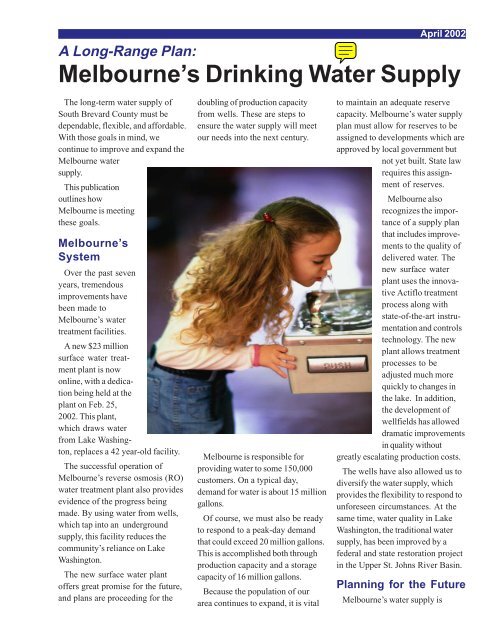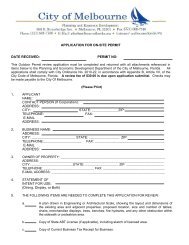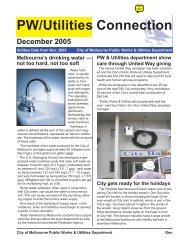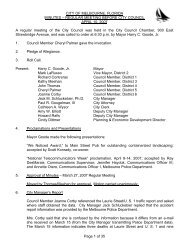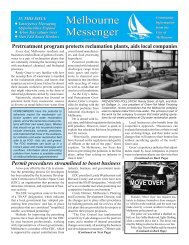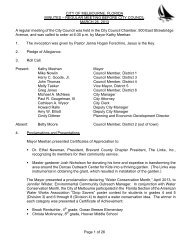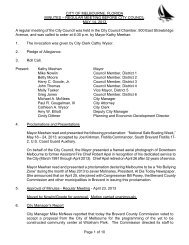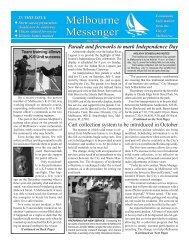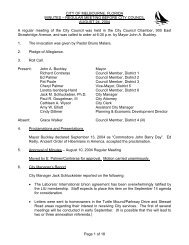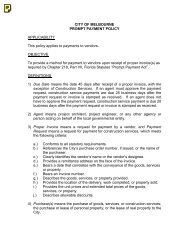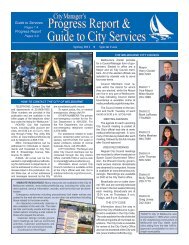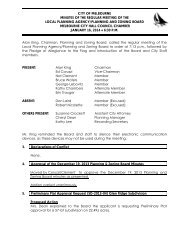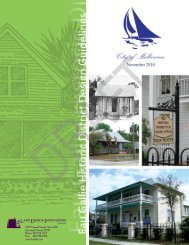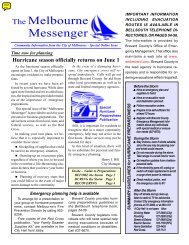Melbourne's Drinking Water Supply - City of Melbourne, Florida
Melbourne's Drinking Water Supply - City of Melbourne, Florida
Melbourne's Drinking Water Supply - City of Melbourne, Florida
You also want an ePaper? Increase the reach of your titles
YUMPU automatically turns print PDFs into web optimized ePapers that Google loves.
April 2002<br />
A Long-Range Plan:<br />
<strong>Melbourne</strong>’s <strong>Drinking</strong> <strong>Water</strong> <strong>Supply</strong><br />
The long-term water supply <strong>of</strong><br />
South Brevard County must be<br />
dependable, flexible, and affordable.<br />
With those goals in mind, we<br />
continue to improve and expand the<br />
<strong>Melbourne</strong> water<br />
supply.<br />
This publication<br />
outlines how<br />
<strong>Melbourne</strong> is meeting<br />
these goals.<br />
<strong>Melbourne</strong>’s<br />
System<br />
Over the past seven<br />
years, tremendous<br />
improvements have<br />
been made to<br />
<strong>Melbourne</strong>’s water<br />
treatment facilities.<br />
A new $23 million<br />
surface water treatment<br />
plant is now<br />
online, with a dedication<br />
being held at the<br />
plant on Feb. 25,<br />
2002. This plant,<br />
which draws water<br />
from Lake Washington,<br />
replaces a 42 year-old facility.<br />
The successful operation <strong>of</strong><br />
<strong>Melbourne</strong>’s reverse osmosis (RO)<br />
water treatment plant also provides<br />
evidence <strong>of</strong> the progress being<br />
made. By using water from wells,<br />
which tap into an underground<br />
supply, this facility reduces the<br />
community’s reliance on Lake<br />
Washington.<br />
The new surface water plant<br />
<strong>of</strong>fers great promise for the future,<br />
and plans are proceeding for the<br />
doubling <strong>of</strong> production capacity<br />
from wells. These are steps to<br />
ensure the water supply will meet<br />
our needs into the next century.<br />
<strong>Melbourne</strong> is responsible for<br />
providing water to some 150,000<br />
customers. On a typical day,<br />
demand for water is about 15 million<br />
gallons.<br />
Of course, we must also be ready<br />
to respond to a peak-day demand<br />
that could exceed 20 million gallons.<br />
This is accomplished both through<br />
production capacity and a storage<br />
capacity <strong>of</strong> 16 million gallons.<br />
Because the population <strong>of</strong> our<br />
area continues to expand, it is vital<br />
to maintain an adequate reserve<br />
capacity. <strong>Melbourne</strong>’s water supply<br />
plan must allow for reserves to be<br />
assigned to developments which are<br />
approved by local government but<br />
not yet built. State law<br />
requires this assignment<br />
<strong>of</strong> reserves.<br />
<strong>Melbourne</strong> also<br />
recognizes the importance<br />
<strong>of</strong> a supply plan<br />
that includes improvements<br />
to the quality <strong>of</strong><br />
delivered water. The<br />
new surface water<br />
plant uses the innovative<br />
Actiflo treatment<br />
process along with<br />
state-<strong>of</strong>-the-art instrumentation<br />
and controls<br />
technology. The new<br />
plant allows treatment<br />
processes to be<br />
adjusted much more<br />
quickly to changes in<br />
the lake. In addition,<br />
the development <strong>of</strong><br />
wellfields has allowed<br />
dramatic improvements<br />
in quality without<br />
greatly escalating production costs.<br />
The wells have also allowed us to<br />
diversify the water supply, which<br />
provides the flexibility to respond to<br />
unforeseen circumstances. At the<br />
same time, water quality in Lake<br />
Washington, the traditional water<br />
supply, has been improved by a<br />
federal and state restoration project<br />
in the Upper St. Johns River Basin.<br />
Planning for the Future<br />
<strong>Melbourne</strong>’s water supply is
www.melbourneflorida.org Page 2<br />
<strong>City</strong> <strong>of</strong> <strong>Melbourne</strong> <strong>Water</strong> Service Area<br />
<strong>Water</strong> Demand Projections<br />
Demand in Millions <strong>of</strong> Gallons Per Day (MGD)<br />
30.00<br />
29.00<br />
28.00<br />
27.00<br />
26.00<br />
25.00<br />
24.00<br />
23.00<br />
22.00<br />
21.00<br />
20.00<br />
19.00<br />
18.00<br />
17.00<br />
16.00<br />
15.00<br />
14.00<br />
13.00<br />
12.00<br />
Dec-03<br />
New Actiflo W.T.P. Expansion - 26.5 MGD<br />
Peak Daily Demand<br />
Dec-08<br />
Dec-13<br />
Average Daily Demand<br />
Dec-18<br />
Year<br />
<strong>Water</strong> storage structures throughout <strong>Melbourne</strong>’s distribution<br />
system stand ready to meet consumers’ demands.<br />
View <strong>of</strong> Lake Washington, <strong>Melbourne</strong>’s surface water source.
www.melbourneflorida.org Page 3<br />
designed to ensure ample water<br />
well beyond the year 2020 for the<br />
communities which we serve.<br />
Construction <strong>of</strong> the second phase <strong>of</strong><br />
the surface water treatment plant<br />
improvement project should begin in<br />
2003. Ozonation will be added as<br />
part <strong>of</strong> this $12.5 million project,<br />
which will replace some chlorination<br />
steps and provide greater control <strong>of</strong><br />
taste and odor.<br />
Construction <strong>of</strong> a second phase <strong>of</strong><br />
the reverse osmosis<br />
plant is anticipated in<br />
the future as well,<br />
which will provide<br />
capacity to accommodate<br />
a 100 percent<br />
build-out <strong>of</strong> the current<br />
service area.<br />
Key components <strong>of</strong><br />
the long-term water<br />
supply plan include:<br />
♦ The new Surface<br />
<strong>Water</strong> Treatment Plant,<br />
which began production<br />
in February 2002, will<br />
continue to draw water from Lake<br />
Washington and will operate with a<br />
peak capacity <strong>of</strong> 20 million gallons<br />
per day (MGD). The capacity <strong>of</strong><br />
this plant can be expanded.<br />
♦ The Joe Mullins Reverse<br />
Osmosis <strong>Water</strong> Treatment Plant,<br />
which began production in 1995, will<br />
continue to operate at a peak<br />
capacity <strong>of</strong> 6.5 MGD. <strong>Water</strong> from<br />
the RO plant will be mixed with<br />
treated water from the surface<br />
water plant to meet daily demands.<br />
♦ An expansion <strong>of</strong> peak capacity<br />
at the RO plant to 13 MGD can be<br />
accomplished. <strong>Melbourne</strong> is exploring<br />
alternative disposal options for<br />
the by-product as a necessary step<br />
toward expanding the RO plant.<br />
Preparing for an<br />
Expansion<br />
By-product from the current RO<br />
plant flows into the Eau Gallie River<br />
just west <strong>of</strong> where it meets the<br />
Indian River Lagoon.<br />
Monitoring is ongoing to determine<br />
that the disposal process causes no<br />
environmental damage. Extensive<br />
technical studies predicted that no<br />
damage would occur, and none has.<br />
The federal Environmental<br />
To the right, water flows after<br />
Actiflo treatment, ready for<br />
filtration.<br />
Protection Agency and the <strong>Florida</strong><br />
Department <strong>of</strong> Environmental<br />
Protection are now considering<br />
<strong>Melbourne</strong>’s applications for permits<br />
to allow the by-product to be<br />
discharged into an injection well at<br />
the D.B. Lee Wastewater Treatment<br />
Facility.<br />
The review process by these<br />
agencies is quite rigorous.<br />
<strong>Melbourne</strong> must show that potential<br />
impacts on the aquifer have been<br />
The operations building <strong>of</strong> the<br />
new surface water treatment<br />
plant is shown to the left.<br />
<strong>Water</strong> treated at this plant is<br />
obtained from Lake<br />
Washington. The green pipe is<br />
for raw water, while the blue<br />
pipe is for finished water.<br />
Shown to the left<br />
are the membrane<br />
trains used to<br />
treat water<br />
obtained from the<br />
<strong>Florida</strong>n Aquifer<br />
wells. The peak<br />
capacity <strong>of</strong> the RO<br />
plant is 6.5 MGD.<br />
Work is in<br />
progress to<br />
expand the plant<br />
capacity.
www.melbourneflorida.org Page 4<br />
thoroughly investigated. A detailed<br />
program <strong>of</strong> monitoring must also be<br />
proposed and approved.<br />
<strong>Melbourne</strong> anticipates approval <strong>of</strong><br />
permits to allow for an expanded<br />
RO capacity.<br />
In planning water production<br />
capacity, <strong>Melbourne</strong> must anticipate<br />
“worst case” peak demand, shown<br />
on the chart on page two.<br />
The <strong>Water</strong> <strong>Supply</strong><br />
System<br />
<strong>Melbourne</strong> has operated a treatment<br />
plant at Lake Washington<br />
since 1959. An experienced and<br />
accredited staff is responsible for<br />
24-hour plant and laboratory operations.<br />
With the recent start-up <strong>of</strong> the<br />
new surface water plant, operators<br />
underwent extensive training on the<br />
new high-tech computerized operating<br />
systems.<br />
With the new plant, delivered<br />
water continues to meet or exceed<br />
the new, even more stringent, state<br />
and federal drinking water standards.<br />
As with the surface water plant,<br />
the start-up <strong>of</strong> the RO plant in 1995<br />
came after additional, specialized<br />
training for plant operators and<br />
support staff.<br />
Finished water from the two<br />
plants enters a distribution system<br />
that includes 850 miles <strong>of</strong> pipeline.<br />
Work to improve the distribution<br />
system is ongoing, as outlined in the<br />
<strong>City</strong>’s water distribution master<br />
plan.<br />
Protecting <strong>Water</strong><br />
Resources<br />
Lake Washington is becoming<br />
more reliable as a water supply.<br />
More water is available and the<br />
quality is improving. The St. Johns<br />
River <strong>Water</strong> Management District<br />
predicted these changes as a<br />
consequence <strong>of</strong> a project started in<br />
1988 to restore portions <strong>of</strong> the St.<br />
Johns River headwaters. The 10-<br />
year project included restoration <strong>of</strong><br />
marshlands and increased the<br />
natural filtering and water-control<br />
processes <strong>of</strong> the river system. The<br />
District also expects water quality<br />
<strong>Melbourne</strong>’s water distribution<br />
system serves about<br />
150,000 people, including the<br />
<strong>City</strong>’s 73,000 residents as well<br />
as these communities:<br />
♦ Indialantic<br />
♦ Indian Harbour Beach<br />
♦ <strong>Melbourne</strong> Beach<br />
♦ <strong>Melbourne</strong> Village<br />
♦ Palm Shores<br />
♦ Satellite Beach<br />
♦ West <strong>Melbourne</strong><br />
♦ Nearby County areas<br />
to be improved by the recent<br />
replacement <strong>of</strong> the weir at the north<br />
end <strong>of</strong> the lake.<br />
The challenges that come with<br />
management <strong>of</strong> the lake as a public<br />
water supply will not vanish. These<br />
include efforts to combat heavy<br />
growths <strong>of</strong> the aquatic weed<br />
hydrilla. <strong>Melbourne</strong> has joined with<br />
the regional water management<br />
district in a hydrilla control program.<br />
Phase I & II — Surface <strong>Water</strong> Treatment Plant Improvements<br />
Lake Washing ton<br />
PAC<br />
Contactor<br />
(Existing<br />
W alker U nits<br />
Nos. 3, 4)<br />
B y-Pass<br />
Ferric Sulfate<br />
(H SO 2 4 /NaoH NaoH)<br />
Actiflo<br />
Ozone<br />
Ozone<br />
Contactor<br />
Gravel-less less<br />
underdrains with<br />
air/water backwash<br />
R.O.<br />
Product<br />
Dual<br />
<strong>Water</strong><br />
Media Filter<br />
GAC<br />
Sand<br />
4-MG<br />
Unbaffled<br />
Blending<br />
Tank<br />
Distribution System<br />
Head <strong>of</strong><br />
Plant<br />
Flow Eq ualization<br />
Tank with<br />
Solids Removal
www.melbourneflorida.org Page 5
www.melbourneflorida.org Page 6<br />
Lab Technician Shaniese Alexander takes<br />
regular samples from various hydrants<br />
throughout the distributions system to bring<br />
to the lab for testing.<br />
Lab Supervisor Yvonne Gonsalves, along with her<br />
staff, perform thousands <strong>of</strong> tests on the <strong>City</strong>’s water<br />
every year and prepare federal and state reports.<br />
<strong>Melbourne</strong> is also prepared<br />
to respond to any threat<br />
from pollutants entering the<br />
lake as a result <strong>of</strong> accidents<br />
or other circumstances.<br />
Obviously, diversifying the<br />
water supply reduces this<br />
threat.<br />
As an additional safeguard,<br />
<strong>Melbourne</strong> has entered into<br />
emergency supply agreements<br />
with both Palm Bay<br />
and Cocoa.<br />
The <strong>Melbourne</strong> distribution<br />
system can receive water<br />
from Cocoa, or send water<br />
into the system. Interconnections<br />
also exist with<br />
Palm Bay.<br />
Existing interconnections<br />
and piping capacities into<br />
<strong>Melbourne</strong>’s system are<br />
listed below, reported in<br />
millions <strong>of</strong> gallons<br />
per day:<br />
Palm Bay<br />
♦ <strong>Florida</strong> Avenue<br />
1.0 MGD<br />
♦ Babcock Street<br />
1.0 MGD<br />
Cocoa<br />
♦ Wickham Road<br />
1.5 MGD<br />
♦ Patrick AFB<br />
1.25 MGD<br />
♦ S. Patrick Drive<br />
1.0 MGD<br />
The RO plant has<br />
already allowed<br />
source diversification.<br />
The water for<br />
that plant is drawn<br />
from three wells just<br />
east <strong>of</strong> Lake Washington,<br />
which tap the <strong>Florida</strong>n<br />
Aquifer.<br />
In implementing the first phase <strong>of</strong><br />
the RO plant, and in planning for the<br />
second phase, necessary permits to<br />
protect the environment and the<br />
community were obtained.<br />
As one part <strong>of</strong> the effort, consultant<br />
engineers determined that<br />
private wells in the vicinity <strong>of</strong> Lake<br />
Washington will not be adversely<br />
impacted by withdrawals from the<br />
<strong>City</strong>’s well field.<br />
Financing the <strong>Water</strong><br />
<strong>Supply</strong><br />
<strong>Melbourne</strong>’s water supply system<br />
is funded by charges to consumers.<br />
The <strong>City</strong> provides service to more<br />
than 50,000 water meter connections,<br />
including meter reading, billing<br />
and collections.<br />
The revenue goes into the <strong>Water</strong><br />
and Sewer Fund. Accounting within<br />
the fund ensures that both the water<br />
services and the sewer services are<br />
self-funding, so that one does not<br />
subsidize the other.<br />
<strong>Water</strong> system revenue provides<br />
for system administration (shared<br />
with the wastewater system),<br />
operations, maintenance, improvements,<br />
and debt services. Total<br />
administrative costs are only 10.4<br />
percent <strong>of</strong> the water and sewer<br />
system budget.<br />
Pr<strong>of</strong>essional services provided to<br />
the water system by other <strong>City</strong><br />
departments are purchased at cost<br />
and paid for by transfers to the<br />
General Fund. This sharing <strong>of</strong> staff<br />
minimizes costs <strong>of</strong> services provided<br />
to the water system<br />
Since the water system is selffunded,<br />
rates reflect the actual costs<br />
<strong>of</strong> providing service. Impact fees
www.melbourneflorida.org Page 7<br />
are in place to allow new development<br />
to pay a fair share <strong>of</strong> the<br />
water supply cost.<br />
<strong>Melbourne</strong> contracts with consultant<br />
firms to calculate rates to<br />
provide financial stability for the<br />
system. Comprehensive rate studies<br />
were conducted in 1985, 1986, 1987,<br />
1991, 1994, 1998, 1999 and 2001.<br />
The current rates are based on the<br />
1998 rate study.<br />
In accordance with state legislation,<br />
the most recent study determined<br />
rates which are appropriate<br />
for service to a diverse and extended<br />
geographical area, including<br />
consumers who live outside <strong>of</strong> the<br />
<strong>Melbourne</strong> city limits.<br />
Adjustments in rates must be<br />
approved by the <strong>City</strong> Council after<br />
public hearings to solicit comments<br />
about rate proposals.<br />
Current rates provided for major<br />
improvements to the Surface <strong>Water</strong><br />
Treatment Plant, as well as major<br />
improvements at the <strong>City</strong>’s wastewater<br />
treatment plants. Those<br />
system improvements were funded<br />
by a $38.8 million, 30-year bond<br />
issue.<br />
Summary<br />
As a water supplier, <strong>Melbourne</strong><br />
looks forward to cooperating with<br />
other cities and Brevard County in<br />
projects to protect, improve, and<br />
expand our drinking water resources.<br />
<strong>Melbourne</strong>’s goal is to provide<br />
high quality water that meets all<br />
health standards, and to do so at the<br />
most economical cost to our customers.<br />
<strong>Water</strong> conservation activities help<br />
preserve our precious resource<br />
In addition to<br />
providing water,<br />
<strong>Melbourne</strong> sponsors<br />
an active water<br />
conservation program<br />
for schools and the<br />
community.<br />
The <strong>City</strong>’s Environmental<br />
Community<br />
Outreach Manager<br />
visits area schools<br />
each year, finding that<br />
young people are<br />
eager to carry the<br />
conservation message<br />
and practices home with them.<br />
Working as a team to pool<br />
resources and enlist support for<br />
community-wide conservation<br />
efforts, a <strong>Melbourne</strong> Groundwater<br />
Guardian Team was formed<br />
five years ago and has accomplished<br />
numerous outreach and<br />
educational projects. Patterned<br />
after the Groundwater Guardian<br />
formula, a committee was formed<br />
almost two years ago, the<br />
Brevard Utilities <strong>Water</strong> Conservation<br />
Committee, made up <strong>of</strong><br />
representatives from the five<br />
public water utilities in Brevard<br />
County. The committee has<br />
produced and distributed educational<br />
posters, newspaper inserts,<br />
<strong>Florida</strong> Friendly Landscaping<br />
seminars for the public and is<br />
working on a video for middle and<br />
high school audiences.<br />
Participation in public events is<br />
also an important method in water<br />
conservation and environmental<br />
education, along with visits with<br />
homeowners groups and discussions<br />
with customers.<br />
Another program instituted in<br />
<strong>Melbourne</strong> five years ago is<br />
having a tremendous direct effect<br />
toward water conservation. The<br />
residential toilet retr<strong>of</strong>it rebate<br />
program has already resulted in<br />
the replacement <strong>of</strong> close to 600<br />
water guzzling toilets with new<br />
water conserving models, estimated<br />
to be saving close to five<br />
million gallons <strong>of</strong> water per year.<br />
The staff is also letting the<br />
community know about the value<br />
<strong>of</strong> irrigation with reclaimed water,<br />
also known as reuse, which<br />
reduces the demand on drinking<br />
water resources. Used widely for<br />
irrigation, customers include many<br />
large businesses and commercial<br />
properties, <strong>City</strong> properties, such<br />
as both <strong>of</strong> <strong>Melbourne</strong>’s golf<br />
courses, and many medians, as<br />
well as large subdivisions.<br />
For more information on programs<br />
or outreach events, please<br />
visit the <strong>City</strong>’s web site at<br />
www.melbourneflorida.org.
www.melbourneflorida.org Page 8<br />
*<br />
*For emergency use only


